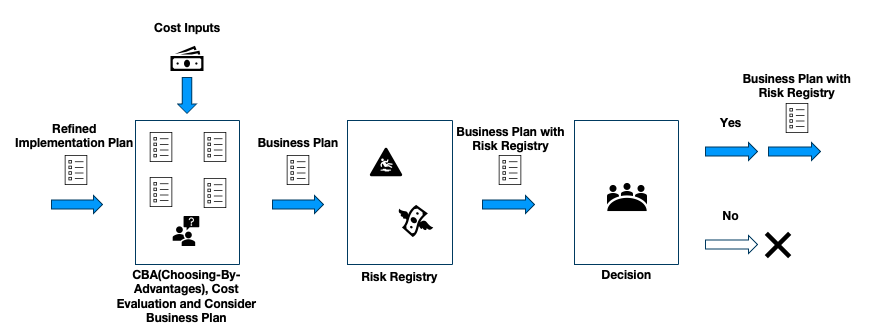5 Make Decision
Objective: This step will create the final decision of implementation based on additional information from a business perspective.

Figure 5.1. Process of Make Decision
The most important aspect of creating a business plan is identifying and mitigating the challenges of integrating robotics into current workflows.
Cost Evaluation and Consider Business Plan:
Cost is a key input that requires deep analysis in order to create a concise business plan. This includes considering the initial cost of the robotics or leasing/renting the robot and the cost of any outsourcing. Regarding buying robotics, cost information, such as purchase price, accessories, consumables, shipping, setup, and training, could be the items to be taken into consideration. When leasing or renting robotics, lease or rent costs, accessories costs, consumables shipping costs, return shipping costs, and training costs are considered. Lastly, when the robotics are outsourced, reviewed information includes inclusive cost per subcontractor, whether consumables are an additional cost, and administration cost to manage a subcontractor. Furthermore, the range of applications associated with the adoption of single-task robotics needed to be defined as well: adopting one or more robotics project-wide or company-wide will significantly impact the management of finance of the company. Typically, adopting robotics in a single or few projects tends to have a cost basis of renting the robotics. On the other hand, using robotics company-wide with multiple projects over the years could lead to the idea of buying robotics. The outsourced cost basis is relatively stand-alone, while it can be applied to both single project-wide and company-wide robotics applications. The template worksheet for this whole step can be found in Appendix G. An example use of this worksheet is shown below in Table 5-1.
Table 5.1. Cost Evaluation Table

Next, to assist with the decision-making between multiple options, the Choosing By Advantages (CBA) method can be used to evaluate the advantages of each opportunity to choose a better option. The table below is the method characteristics table, defining the desired attributes or minimum requirements of the method chosen and method selection, and it weighs the method to help with planning. First, use this table to determine the desired attributes necessary for each factor. Decide how each robotics and method aligns with those desired attributes. Then, rank each of the factors based on priority and importance. Score each method or robot based on how well it aligns with the desired attributes of the factor. The template worksheet for this CBA can be found in Appendix H. An example use of this worksheet is shown below in Table 5-2.
Table 5.2. The Choosing By Advantages Example

Risk Registry:
A crucial aspect of developing a business plan is analyzing the potential risks that robotics can bring to or remove from a construction project. Reviewing changes to the project risk analysis and answering the questions defined below is important. The template worksheet for this CBA can be found in Appendix I.
- What risks are mitigated by the use of construction robotics?
- What risks are increased through the use of construction robotics?
- What new risks are created by implementing construction robotics?
- What are the potential financial damage or advantages associated with implementing construction robotics?
- How can the team mitigate the risks above?
Decision:
Based on the business plan with a risk registry, the team can reasonably decide whether the team would go for the implementation or not.

